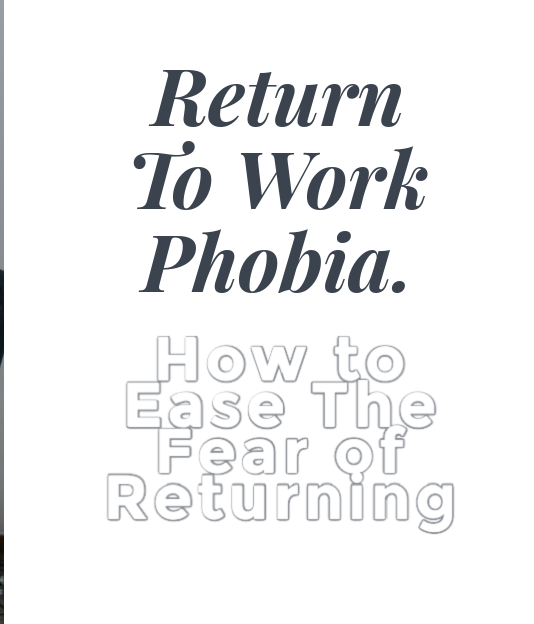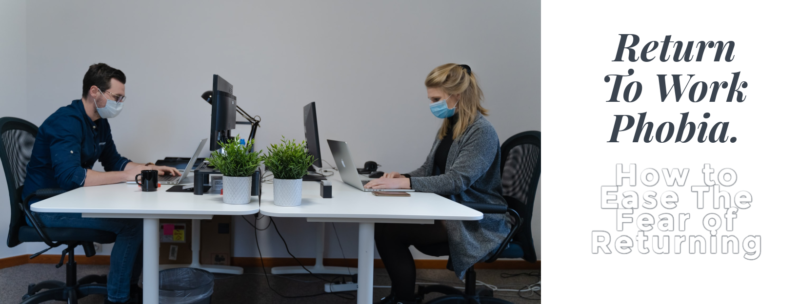What can leaders can do to ease the fear of returning to work after Covid?
Many people are dreading the return to work: the commute, unnecessary in-person meetings, sitting a cubicle, eating lunch at their desk…
For over a year, public health messaging has been that the safest place to be is your home, so it is hard to turn off that messaging just because your cubicle wants you back. Only 44% of workers are comfortable going to a workplace outside their homes. 2/3 thirds have anxiety over returning to work.
Some of the reasons for this anxiety are:
- Fear of infection
- Many households have someone who is vulnerable to Covid due to underlying health issues
- In the midst of grieving
- 600,000+ people died of Covid, which means many more of us are still adjusting to life without a family member compared to a non-pandemic time
- Distrust of medical institution recommendations
- Changing science recommendations as we learned more about the virus, plus a history of inadequate care for Black and Brown people, lead some to distrust any recommendations, including the Covid vaccine
- Daycare shortage
- Many in-home daycares went out of business, and large centers are having trouble hiring staff
- Isolation = depression
- The isolation needed for the pandemic could have led to undiagnosed or unidentified depression, so for some, anxiety about returning to work may be a symptom of something larger
- Resistance to change
- Always a certain percentage of people who just do not want change or are not sure what they want their post-pandemic normal to be – Read more about this in the article Yes, We are There! Or Are We There Yet?
Many people are voting with their feet by leaving jobs that are requiring them to transition back to the cube lifestyle and choosing jobs that offer a more flexible hybrid model or to not work at all.
While many decisions about the transition back to the office are made by the organization, many of those decisions focus on the physical environment: protective plexiglass, higher cube walls, new barriers, mask rules, installation of numerous sanitizer dispensers, reduced room occupancy rate, temperature screenings, etc.
This means that supervisors and managers need to focus on the emotional needs and recognize the true trauma that many faced and are still facing because of the pandemic. While many leaders may feel that handling staff emotions falls outside their roles, research will tell you that that employees who feel their concerns and well-being are being addressed by employers are far, far less likely to seek new employment. And, having flexible policies to accommodate the transition will help you hire all those people leaving their inflexible roles.
Five Actions for Leaders to Manage Return-to-Work Phobia After Covid
- Proactively address concerns with your individual team members:
- When you sense or hear statements that relate to Return-to-Work anxiety, have a conversation with the person and ask that person to bring the root cause and suggestions for addressing it to you.
- If someone proactively brings up concerns, be honest and sincere about finding solutions within the organization’s policies.
- Remind employees about Employee Assistance Programs.
- Encourage employees to know and pay attention to their own stress warnings: clenched jaw, quick breathing, fidgeting, neck or shoulder pain, etc.
- Rethink your communication plan:
- Clearly communicate the organization’s return-to-work expectations to your staff. Even if the organization sends a mass message, reiterate what that means for your team.
- If the organization’s expectations are not clear to you, request more communication from your own leadership.
- Update frequently. We are still in a time of new information and new guidelines; keep updating as necessary.
- If you have some people still working from home, make sure you include them in all communications. One of the biggest complaints from remote workers is lack of information from their leaders.
- Consider daily check-ins with staff, not on work getting done, but on how they are feeling. Keep your finger on the pulse of their health, families’ health needs, caregiving to extended family, changes in daycare and school situations. Let people know that it is OK to not feel OK.
- Experiment on working models, if you can:
- If you do not need to nail down a new working model, take time now to try out different modes, schedules, and combinations to find the one that works best for your team.
- Offer the option of an iterative change back to the office.
- Invite your staff to provide suggestions and feedback on a creating a safe workspace to add a sense of control.
- Be prepared for special accommodations, flexible work time, modified work schedule. If in a union environment, also pay attention to contract constraints, and know that accommodations for one person without official paperwork, may need to extend to all.
- Be flexible and realistic with expectations. Even though people are returning to the familiar, it is still a change, and normal change curve phases (Denial, Resistance, Acceptance, Commitment) will apply.
- Be optimistic:
- Optimism, joy, gratitude, and humor can spread the same way that fear and anxiety is spread.
- Reinstate the fun aspects of being in the office together. Celebrations, ordering lunch in, wearing jerseys for game days, etc.
- Consider how to virtually loop in those who work from home to have fun too.
- Give your team time to interact without you. Colleagues are more excited about seeing each other than they are for more face-time with their boss.
- Focus on wellness for yourself (and encourage your staff to do the same):
- As always, practice a healthy diet, get plenty of sleep, and get some exercise.
- Fear can weaken your immune system. Eliminate or limit activities that increase anxiety, such as:
- Watching a news show (look for 5- minute news summary option)
- Having conversations that only focus on negativity and fear
Using these 5 strategies can help you reduce your concern and the concerns of your staff as you transition back to the workplace.
Beth Schaefer,
IPD Director
Sources
-
After a Year of Remote Life, New Anxiety Emerges; Returning to Work by Paul Caine from PBS in Chicago
-
Back to the Office Anxiety? How to Keep Your Fears in Check by Dr. Margie Warrell from Forbes
-
Child Care Crisis will Linger After Pandemic by Pat Baustian and Heidi Omerza from Star Tribune
-
Do You Have a Fear of Returning to the Office? By Emma Beddington from The Guardian
-
Why fear is the greatest obstacle to Returning to Work? by Allison Velex from SHRM
-
Years of Medical Abuse Make Black Americans Less Likely to Trust Covid Vaccine by Dan Royles from the Washington Post





